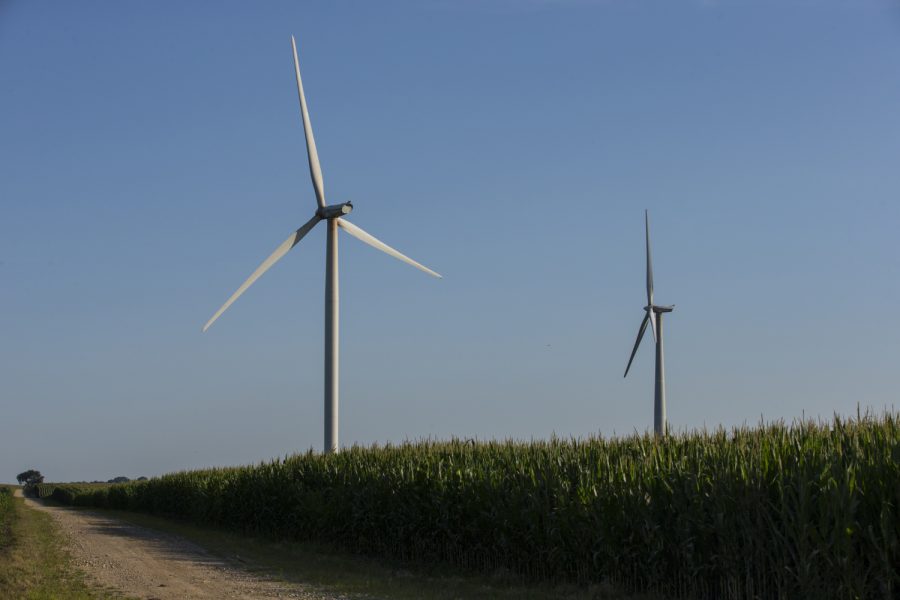UI professor looks toward a carbon-free Iowa
A Decarb Iowa 2040 study by University of Iowa Chemical and Biochemical Professor Charles Stanier outlines how Iowa can be energy independent through investment in research and clean energy infrastructure.
Windmills are seen in Mechanicsville, IA on Wednesday, July 11, 2018.
November 9, 2021
Targeted investment in clean energy infrastructure could help Iowa be carbon-free by 2040.
Decarb Iowa 2040, a study project headed by University of Iowa Chemical and Biochemical Engineer Professor Charles Stanier, outlines how Iowa can become energy independent using wind, solar, and bioenergy technologies.
The research also covers how Iowa can achieve energy independence without increasing expenses that could harm rural communities.
Iowa currently uses over 10 percent of its annual gross domestic product to fund infrastructure maintenance and repairs, Stanier said.
Stanier said one of the biggest hurdles Iowa faces is the cost of investing in more renewable power generation technology across the state.
“You can’t just shift money from old technology to new,” Stanier said. “You have to add new money into it.”
According to an International Renewable Energy Agency report, wind and solar technology have been historically more expensive than subsidized fossil fuels. In 2018, the agency found that the price of renewable technologies had declined and even outcompeted fossil fuels by a large margin.
Iowa has a strong wind energy industry that generated over 36 percent of the state’s electricity in 2016, according to the Iowa Environmental Council.
Energy companies in Iowa are creating wind farms to expand their commitment to sustainable energies. MidAmerican owns 3,300 wind turbines across the state that generate electricity for over 2.3 million households each year.
Ion Vasi, UI sociology and criminology associate professor and co-collaborator for the Decarb Iowa 2040 study, said while investment in wind energy can be expanded, Iowa has the potential to be a leader in solar power as well.
“Currently about 3 percent of electricity is generated through solar power right now, so there’s a lot of room for growth and potential,” Vasi said.
Iowa had a tax credit incentive to make solar power installation more attractive to businesses and homeowners. The tax credit offsets the upfront cost of installing the panels. However, the tax credit is set to expire for residential installations at the end of 2021.
Vasi said, with the state tax credit expiring, there will need to be more investment in solar power research to make it more efficient and less expensive upfront for consumers.
Another renewable energy the study looks at is bioenergy, specifically biofuels like ethanol. Iowa is one of the top producers of ethanol in the country. According to the Iowa Corn Growers Association, Iowa creates nearly 30 percent of the country’s ethanol.
Stanier said while ethanol burns clean, more research needs to be conducted on how to make it more sustainable.
By investing more money into these renewable energies and the decarbonization of Iowa’s energy infrastructure, there could be economic benefits, Stanier said.
According to the World Resources Institute, more jobs have already been created in the U.S. clean energy sector. In 2019, clean energy jobs created outnumbered fossil-fuel jobs by 3:1.
In Iowa, jobs in the clean energy sector increased 3.6 percent from 2018 to 2019. Overall, clean energy jobs account for roughly 2 percent of Iowa’s workforce, a Clean Jobs Midwest report said.
Stanier said, because of the increase of clean energy production in Iowa, more companies that specialize in renewable energy technology and infrastructure may want to expand their businesses in Iowa, creating more jobs and economic opportunities.
The path to energy independence and decarbonization in Iowa is going to take a long time and a lot of money, but it’s not impossible, Stanier said.
“There’s a lot of money to be made to figure out how to do what we do with less emissions,” he said. “That money is just coming from all of us.”



